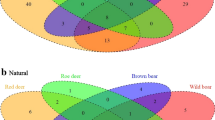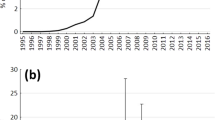Abstract
Seed dispersal is essential for the success of plants, allowing them to find advantageous areas to inhabit while avoiding inbreeding. Although predominantly anemochoric, grasses (Poaceae) have evolved other ways to disperse their diaspores, such as zoochory and also ballistochory (forcible dispersal), which is considered rare within this family. To date, ballistochory in grasses is only known for the sister genera Raddia and Sucrea, Neotropical herbaceous bamboos (tribe Olyreae). In this study, this dispersal syndrome is confirmed for Reitzia, a monospecific herbaceous bamboo genus and member of the Piresia clade, which is restricted to the Atlantic forest in southeastern and southern Brazil. We hypothesize that the pedicel of the pistillate spikelet, more than the glumes, may be responsible for the ballistic movement. We also provide an updated conservation assessment and a distribution map for the genus.





Similar content being viewed by others
References
Aleixo A (1999) Effects of selective logging on a bird community in the Brazilian Atlantic Forest. Condor 101:537–548
Bachman S, Moat J, Hill AW, de la Torre J, Scott B (2011) Supporting Red List threat assessments with GeoCAT: geospatial conservation assessment tool. ZooKeys 150:117–126
Carvalho MLS, de Jesus ISD, Bezerra HB, Oliveira ILC, van den Berg C, Schnadelbach AS, Clark LG, Oliveira RP (2021) Phylogenetics of Piresia (Poaceae: Bambusoideae) reveals unexpected generic relationships within Olyreae with taxonomic and biogeographic implications. Taxon 70:492–514
Chapman GP (1996) The biology of grasses. CAB International, Wallingford
Clark LG, Oliveira RP (2018) Diversity and evolution of the New World bamboos (Poaceae: Bambusoideae: Bambuseae, Olyreae). In: Lucas S (ed) Proceedings of the 11th World Bamboo Congress, Xalapa, Mexico, pp 35–47
Clayton WD (1990) The spikelet. In: Chapman GP (ed) Reproductive versatility in the grasses. Cambridge University Press, Cambridge, pp 32–51
Clayton WD, Renvoize SA (1986) Genera graminum: grasses of the world. Her Majesty’s Stationery Office, London
Clayton WD, Vorontsova MS, Harman KT, Williamson H (2006) GrassBase-The Online World Grass Flora. http://www.kew.org/data/grasses-db.html. Accessed 22 October 2022
CNCFlora (2012) Reitzia smithii in Lista Vermelha da flora brasileira versão 2012.2. Centro Nacional de Conservação da Flora. http://cncflora.jbrj.gov.br/portal/pt-br/profile/Reitzia smithii. Accessed 22 October 2022
Davidse G (1987) Fruit dispersal in the Poaceae. In: Soderstrom TS, Hilu KW, Campbell CS, Barkworth ME (eds) Grass systematics and evolution. Smithsonian Institution, Washington, pp 143–155
Davidse G, Morton M (1973) Bird-mediated fruit dispersal in the tropical grass genus Lasiacis (Gramineae: Paniceae). Biotropica 5:162–167
Develey PF, Peres CA (2000) Resource seasonality and the structure of mixed species bird flocks in a coastal Atlantic Forest of southeastern Brazil. J Trop Ecol 16:33–53
Doust AN, Mauro-Herrera M, Francis MD, Shand LC (2014) Morphological diversity and genetic regulation of inflorescence abscission zones in grasses. Am J Bot 101:1759–1769
Eriksson O, Kiviniemi K (2001) Evolution of plant dispersal. In: Vuorisalo TO, Mutikainen PK (eds) Life history evolution in plants. Kluwer, Dordrecht, pp 215–237
Estornell LH, Agusti J, Merelo P, Talon M, Tadeo FR (2013) Elucidating mechanisms underlying organ abscission. Plant Sci 199–200:48–60
Ferreira FM, Oliveira RP, Welker CAD, Dórea MC, Lima ALC, Oliveira ILC, Santos FAR, van den Berg C, Clark LG (2019) Phylogenetic relationships within Parianinae (Poaceae: Bambusoideae: Olyreae) with emphasis on Eremitis: evidence from nuclear and plastid DNA sequences, macromorphology, and pollen ectexine patterns. Mol Phylogenet Evol 139:106541
Flora e Funga do Brasil (2023) Jardim Botânico do Rio de Janeiro. http:// floradobrasil.jbrj.gov.br/. Accessed 22 September 2023
Gallaher TJ, Peterson PM, Soreng RJ, Zuloaga FO, Li D-Z, Clark LG, Tyrrell CD, Welker CAD, Kellogg EA, Teisher JK (2022) Grasses through space and time: an overview of the biogeographical and macroevolutionary history of Poaceae. J Syst Evol 60:522–569
Gibson DJ (2008) Grasses and grassland ecology. Oxford University Press, Oxford
GPWG (Grass Phylogeny Working Group) (2001) Phylogeny and subfamilial classification of the grasses (Poaceae). Ann Missouri Bot Gard 88:373–457
Howe HF, Smallwood J (1982) Ecology of seed dispersal. Annu Rev Ecol Syst 13:201–228
INEA (Instituto Estadual do Ambiente) (2015) Plano de manejo (fase 1). Área de Proteção Ambiental Estadual de Mangaratiba. Diretoria de Biodiversidade e Áreas Protegidas (DIBAP), Rio de Janeiro
IUCN Standards and Petitions Committee (2022) Guidelines for using the IUCN Red List categories and criteria. Version 15.1. Prepared by the Standards and Petitions Committee. http://www.iucnredlist.org/documents/RedListGuidelines.pdf. Accessed 22 October 2022
Janzen DH (1971) Seed predation by animals. Annu Rev Ecol Syst 2:465–492
Judziewicz EJ, Clark LG, Londoño X, Stern MJ (1999) American bamboos. Smithsonian Institution, Washington
Kellogg EA (2015) Flowering plants: Monocots: Poaceae. In: Kubitzki K (ed) The families and genera of vascular plants, vol XIII. Springer International, Cham, pp 1–416
Liljegren SJ (2012) Organ abscission: exit strategies require signals and moving traffic. Curr Op Plant Biol 15:670–676
Lorts CM, Briggeman T, Sang T (2008) Evolution of fruit types and seed dispersal: a phylogenetic and ecological snapshot. J Syst Evol 46:396–404
Oliveira RP, Clark LG, Schnadelbach AS, Monteiro SHN, Borba EL, Longhi-Wagner HM, van den Berg C (2014) A molecular phylogeny of Raddia and its allies within the tribe Olyreae (Poaceae, Bambusoideae) based on noncoding plastid and nuclear spacers. Mol Phylogenet Evol 78:105–117
Oliveira ILC, Matos AO, Silva C, Carvalho MLS, Tyrrell CD, Clark LG, Oliveira RP (2020a) Delving deeper into the phylogenetics of the herbaceous bamboos (Poaceae, Bambusoideae, Olyreae): evaluation of generic boundaries within the Parodiolyra/Raddiella clade uncovers a new genus. Bot J Linn Soc 192:61–81
Oliveira RP, Silva C, Welker CAD, Dórea MC, Oliveira ILC, Vieira JPS, Leite KRB, Clark LG (2020b) Reinterpreting the phylogenetic position, systematics and distribution of the Raddia-Sucrea lineage (Poaceae, Olyrinae), with a new monotypic and endangered herbaceous bamboo genus from Brazil. Bot J Linn Soc 192:34–60
Rezende CL, Scaranoa FR, Assadd ED, Joly CA, Metzger JP, Strassburg BBN, Tabarelli M, Fonseca GA, Mittermeier RA (2018) From hotspot to hopespot: an opportunity for the Brazilian Atlantic Forest. Perspect Ecol Conserv 16:208–214
Ribeiro MC, Metzger JP, Martensen AC, Ponzoni FJ, Hirota MM (2009) The Brazilian Atlantic Forest: how much is left, and how is the remaining forest distributed? Implications for conservation. Biodivers Conserv 142:1141–1153
Richards PW (1996) The tropical rain forest: an ecological study, 2nd edn. Cambridge University Press, Cambridge
Sendulsky T (1993) First report of ballistochory in the Poaceae. Ann Missouri Bot Gard 80:518–521
Shorthouse DP (2010) SimpleMappr, an online tool to produce publication-quality point maps. http://www.simplemappr.net. Accessed 22 October 2022
Silva C, Conde MMS, Longhi-Wagner HM (2012) Olyreae (Poaceae: Bambusoideae) da Marambaia, Rio de Janeiro, Brasil. Rodriguésia 63:357–372
Soderstrom TR, Calderón CE (1974) Primitive forest grasses and evolution of the Bambusoideae. Biotropica 6:141–153
Soderstrom TR, Zuloaga FO (1985) New species in Arberella, Cryptochloa, and Raddia (Poaceae: Bambusoideae: Olyreae). Brittonia 37:22–35
Soreng RJ, Peterson PM, Zuloaga FO, Romaschenko K, Clark LG, Teisher JK, Gillespie LJ, Barberá P, Welker CAD, Kellogg EA, Li D-Z, Davidse G (2022) A worldwide phylogenetic classification of the Poaceae (Gramineae) III: an update. J Syst Evol 60:476521
Stapf O (1906) Diandrolyra Stapf., gen. nov. (Gramineae – Olyeae). Bull Misc Inform Kew 1906:204–205
Swallen JR (1956) New grasses from Santa Catarina. Sellowia 7:7–12
Swallen JR (1964) Two new genera of Olyreae from South America. Phytologia 11:152–154
Thiers B (2023, continuously updated) Index Herbariorum: a global directory of public herbaria and associated staff. New York Garden’s Virtual Herbarium. http://sweetgum.nybg.org/ih/ herbarium. php?irn=174420. Accessed 22 September 2023
van der Pijl L (1982) Principles of dispersal in higher plants, 3rd edn. Springer, New York
Watson L, Dallwitz MJ (1992) The grass genera of the world: descriptions, illustrations, identification, and information retrieval; including synonyms, morphology, anatomy, physiology, phytochemistry, cytology, classification, pathogens, world and local distribution, and references. http://delta-intkey.com/. Accessed 22 October 2022
Welker CAD, McKain MR, Estep MC, Pasquet RS, Chipabika G, Pallangyo B, Kellogg EA (2020) Phylogenomics enables biogeographic analysis and a new subtribal classification of Andropogoneae (Poaceae–Panicoideae). J Syst Evol 58:1003–1030
Willson MF (1993) Dispersal mode, seed shadows, and colonization patterns. Vegetatio 107:261–280
Willson MF, Traveset A (2000) The ecology of seed dispersal. In: Fenner M (ed) Seeds: the ecology of regeneration in plant communities, 2nd edn. CABI Publishing, Wallingford, pp 85–110
Acknowledgements
We are grateful to the Conselho Nacional de Desenvolvimento Científico e Tecnológico, Brazil (CNPq—grants 426334/2018-3, 441760/2020-1) and Fundação de Amparo à Pesquisa do Estado de Minas Gerais (FAPEMIG—grants APQ-01222-21, APQ-03365-21) for financial support. FMF also thanks Coordenação de Aperfeiçoamento de Pessoal de Nível Superior, Brazil (CAPES) (PNPD), and RPO (PQ-1C) and CADW (PQ-2) thank CNPq for the fellowships received.
Author information
Authors and Affiliations
Contributions
FMF reviewed herbaria, performed the experiment, wrote the manuscript, and prepared the illustrations and maps. RPO reviewed herbaria and reviewed the manuscript. CADW, CS, and LGC contributed to the interpretation during the writing of the manuscript and reviewed it.
Corresponding author
Ethics declarations
Conflict of interest
The authors declare that they have no conflict of interest.
Additional information
Publisher's Note
Springer Nature remains neutral with regard to jurisdictional claims in published maps and institutional affiliations.
Rights and permissions
Springer Nature or its licensor (e.g. a society or other partner) holds exclusive rights to this article under a publishing agreement with the author(s) or other rightsholder(s); author self-archiving of the accepted manuscript version of this article is solely governed by the terms of such publishing agreement and applicable law.
About this article
Cite this article
Ferreira, F.M., Silva, C., Oliveira, R.P. et al. Ballistochory in the herbaceous bamboo genus Reitzia (Poaceae, Bambusoideae, Olyreae): the second report of this dispersal syndrome in grasses. Braz. J. Bot 46, 1079–1087 (2023). https://doi.org/10.1007/s40415-023-00944-2
Received:
Revised:
Accepted:
Published:
Issue Date:
DOI: https://doi.org/10.1007/s40415-023-00944-2




